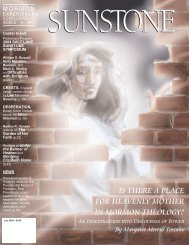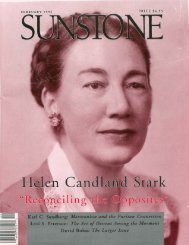Download Entire Issue PDF - Sunstone Magazine
Download Entire Issue PDF - Sunstone Magazine
Download Entire Issue PDF - Sunstone Magazine
You also want an ePaper? Increase the reach of your titles
YUMPU automatically turns print PDFs into web optimized ePapers that Google loves.
S U N S T O N E<br />
in the sight of God, that it was the will of God, &c.” Hyde<br />
tried to be helpful by adding that he had “never heard Smith<br />
use similar language before,” insisting further: “I have<br />
known him for some time and think him to be possessed of<br />
much kindness and humanity towards his fellow beings.”<br />
Likewise, apostle Luke S. Johnson acknowledged to the<br />
court that Joseph had said “if Newell or any other man<br />
should head a mob against him, they ought to be put out of<br />
the way, and it would be our duty to do so.” However,<br />
Johnson also affirmed: “I believe Smith to be a tenderhearted,<br />
humane man.” Whether or not the court agreed<br />
with that assessment, the judge acquitted Joseph because<br />
there was insufficient evidence to support the charge of conspiracy<br />
to commit murder. 59<br />
In the fall of 1837, David W. Patten investigated the<br />
Prophet’s secret relationship with his servant girl Fanny<br />
Alger, 60 and the hapless apostle collided with Smith’s code of<br />
male honor. Brigham Young described what happened:<br />
“David in[sult]ed Joseph & Joseph slap[p]ed him in the face<br />
& kicked him out of the yard.” 61<br />
However, the Mormon Prophet’s code of honor took offense<br />
at far lesser provocations. Benjamin F. Johnson reminisced<br />
that “criticism, even by his associates, was rarely acceptable,<br />
and contradiction would rouse in him the lion at<br />
once, for by no one of his fellows would he be superseded or<br />
disputed and in the early days at Kirtland, and elsewhere[,]<br />
one or more of his associates were more than once, for their<br />
impudence, helped from the congregation by his (Joseph’s)<br />
foot.” 62<br />
When armed dissenters joined anti-Mormons in forcing<br />
the Prophet and his loyal followers to flee Kirtland in<br />
January 1838, 63 this event solidified a world view that was<br />
indelible throughout the rest of the nineteenth century:<br />
Mormonism was fighting for its life against conspiracies of<br />
anti-Mormons and Mormon traitors. Every generation of the<br />
Mormon hierarchy remembers this heritage of anti-Mormon<br />
persecutors and collaborating apostates. This is the context<br />
in which, as Marvin S. Hill observed, “the desire for refuge<br />
from pluralism and the uncertainty of choice in a free society<br />
encouraged a quest to eliminate opposition both within and<br />
without the [LDS] Church through intimidation and, when<br />
necessary, violence.” 64<br />
Some of Kirtland’s dissenters also resettled at the new<br />
Mormon headquarters of Far West, Missouri, where they associated<br />
with local dissenters. Joseph and his loyal followers<br />
were determined to prevent these formerly faithful leaders<br />
from causing mass disaffection a second time. They pursued<br />
this aim through an organization which functioned both<br />
militarily and theocratically.<br />
IN EARLY JUNE 1838, Sampson Avard—who considered<br />
himself an ultra-loyal Mormon—proposed organizing<br />
the “Danites” among other ultra-loyal Mormons.<br />
The Danites were the first civil appendage of Mormon power<br />
since 1834. Some historians have claimed that Joseph Smith<br />
and the rest of the First Presidency were unaware of the<br />
C. C. A. Ch r is t en s en : Det Ail f r o m “h Au n ’s mil l ”<br />
OCTOBER 2011 PAGE 21

















